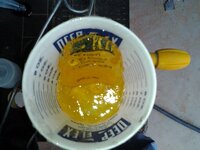Haynie
Member
Not a happy camper right now. I mixed up a large amount of 15 minute Mercury Epoxy which was bought last winter. Both bottles were clear and when I have used it in the past it cured clear with no yellowing. I never mixed this much up before though. I needed to plug some knot holes in some flat work I am doing and wanted it to be clear, so I mixed it all up because I was going to need it all.
It was clear when I mixed it. Clear when I started pouring it. I poured two boards and went to grab the next two. Total time 6 minutes from mix to pour to getting back with the next boards. I had a timer running. This is what it looked like. I tried to pour a little into another cup to see if it would cure clear. It never got out of the cup as you can see, and it was freaking hot!
We will see what things look like in the morning, but as of now the board with the largest knot looks like crap. I have enough wood to replace this board thank goodness.
I opened my mercury 30 minute epoxy box which I have never opened and the hardener is pee yellow. Looks like I am in the market for some different epoxy.
It was clear when I mixed it. Clear when I started pouring it. I poured two boards and went to grab the next two. Total time 6 minutes from mix to pour to getting back with the next boards. I had a timer running. This is what it looked like. I tried to pour a little into another cup to see if it would cure clear. It never got out of the cup as you can see, and it was freaking hot!
We will see what things look like in the morning, but as of now the board with the largest knot looks like crap. I have enough wood to replace this board thank goodness.
I opened my mercury 30 minute epoxy box which I have never opened and the hardener is pee yellow. Looks like I am in the market for some different epoxy.
Attachments
Last edited:

